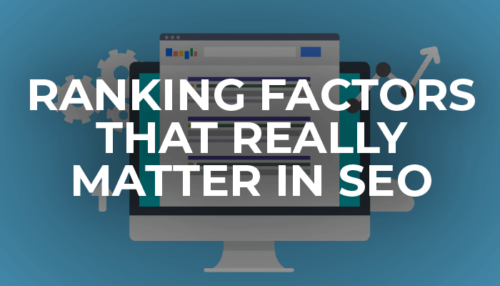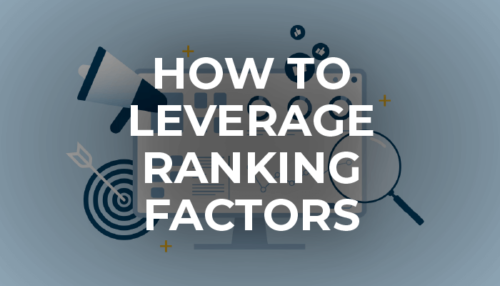Ranking Factors That Actually Matter
Search Engines like Google rank webpages according to ever-increasing criteria within algorithms. These are called Ranking Factors, and they weigh aspects of your site and pages according to the requirements of each piece of the algorithm.
So, with so many blogs on the topic, we’re going to boil it down from over 200 to around 20 you can focus on with a snowball effect on other factors.
- High-quality content
- Mobile-first
- Page Experience
- Page speed
- On-page optimization
- Internal links
- External links

1. High-Quality Content
High-quality content is a major ranking factor for organic search engine optimization. So, you need to hone in on helpful content according to a few factors:
- E-E-A-T
- Keyword Research
- Keyword Usage
- Freshness
What is E-E-A-T?
The acronym E-E-A-T stands for Experience, Expertise, Authoritativeness, and Trustworthiness. Google evaluates the quality of content according to personal experience, subject expertise, and your reviews to show authority and maintain trustworthiness through credible sources and accurate information.
Part of E-E-A-T includes determining how helpful your content is when a user searches for a term and how long they spend reading your page (i.e., engaging with it).
What’s Keyword Research in Ranking Factors?
Identifying the most relevant and popular search terms related to your website’s niche helps you to get closer to number one. Google looks for broad and exact matches to rank content, so you don’t have to use those long tails exactly. Keeping queries within context is another ranking factor that will improve your standings.
Most businesses find SEO “cold” to read and want a more personal touch, so the balance of keywords must fit into an approachable format without sacrificing relevance. However, you should aim all over the search volumes, not just the highest.
Keyword Usage Ranking Factors
Once you have enough keywords, consider how to use them and where. You can leverage average search volumes through competitor research and data mining but get a higher click-through rate for your audience.
Research is a roadmap for content creation and improves the quality of what you put out. Be sure to check the lengths of competitor content so you don’t underserve information. Then, look at placing keywords similarly to match users’ current needs.
Freshness: Evergreen Needs an Update
Content freshness is an old ranking factor, but it means more nowadays. Evergreen content should be updated with more than a date change. Dive into the whole page and adjust images, lists, or other information that matter for the topic.
Many SEO experts recommend quarterly content audits to ensure that pieces always offer helpful content and that nothing is too similar to rank independently. However, always back up your changes with data and research.
2. Mobile-First Ranking Factors
No one will tote a laptop around forever, but they cart around a super-fast computer in their pocket. So, optimizing a website for mobile is vital to getting to the top of the leaderboard. Your website needs to scale to any screen size and be easy to navigate quickly. So, check that every smartphone aspect works regularly and fix it before the following index.
Google now ranks websites according to mobile-first, which means your future rankings depend on how useable the site is across all devices. Use the Mobile-Friendly test to check that images, videos, and other assets load quickly.
Mobile Usability
Google recommends a responsive website over other options for mobile-first indexing. It helps the algorithms “accurately assign indexing properties” instead of signaling corresponding desktop/mobile versions.
Thus, a mobile-first site is vital to your SERPs, so follow Google’s guidelines to ensure your users get a good page experience.
3. Page Experience
A major recent ranking factor is page experience, measured by how long users spend on a page and where they go afterward. Some things that affect it are User Experience, Site Architecture, Security, and Ad Experience. These are easy to maintain but take time to set up.
User Experience
If your user experience isn’t up to par, your website will end up in the bottom rungs of SERPs. Studies show that 38% of people stop engaging if the layout and content are unattractive. We don’t notice good design, but we see lousy design.
Getting your UX right has significant impacts, such as when Main Street Host saw a 66% increase in views when they improved attorney profile pages by fixing the content and optimizing call-to-action buttons. Meanwhile, Ezoic benchmarked a 186% increase per 1000 visitors after updating UX.
Pairing a good design with SEO is vital to getting organic traffic and user satisfaction.
Site Architecture
The proverbial library of your site needs an easy way to navigate and find what’s needed. So, your most significant impact is sensibly organizing your pages.
Better website navigation can also improve bot indexing. Thus, websites must be dead easy to use in only three to four clicks. Moreover, adding a search function can cut that in half for deeper pages.
Remember: unlike you, your ideal user is probably lazy and wants quick answers.
HTTPS Secure Website
As a ranking factor, secure websites are near the top. Keeping your site safe makes you trustworthy and stops outside elements from using you as a gateway to your users.
Not making the transition has led to increased bounce rates. Another step is to add Secure Sockets Layer (SSL) encryption to prevent information scraping. So, switch your site over (if you haven’t already) to benefit from better trust and indexing.
Ad Experience: Ranking Factors
Ad Experience was rolled out in 2017 and has affected many sites. If you violate Better Ads Standards, Chrome can remove all ad spaces from your website. Plus, aggressive ads could tank your site.
Ad experience affects Core Web Vitals, too, which makes improving your page ad experience a vital factor.

4. Page Speed Ranking Factors
Implementing these steps can significantly improve your website’s page speed, leading to a better user experience and potentially higher search engine rankings.
Here are steps to help you achieve faster page loading times:
Compress Images
Use image compression tools to reduce file sizes without compromising quality. Smaller image files load faster. Consider using next-gen image formats like WebP for better compression.
5. On-Page Optimization Ranking Factors
On-page optimization is an ongoing process that requires a balance between catering to search engine algorithms and providing a valuable experience for users. Executing effectively can lead to improved rankings, increased organic traffic, and a more engaged audience.
- Title Tags: Craft compelling and descriptive tags for each page, including the primary keyword. Keep titles concise (around 50 characters) and enticing to encourage click-throughs in search results.
- Meta Descriptions: Write concise meta descriptions (around 130 characters) summarizing the page’s content and including the target keyword. A well-crafted meta description can improve click-through rates.
- Headings (H1, H2, H3, etc.): Structure your content with clear headings (H1 for the main title and H2, H3 for subheadings). Use keywords naturally within headings to help search engines understand your content’s hierarchy and relevance.
- Images and Alt Tags: Optimize images by reducing file sizes and using descriptive alt text. Alt text helps search engines understand image content, and it’s crucial for accessibility.
- Page Speed: Improve page load times by optimizing images, minimizing unnecessary code, and leveraging browser caching. Both users and search engines favor faster-loading pages.
- Schema Markup: Implement structured data or schema markup to provide search engines with additional context about your content. This can lead to rich snippets in search results, enhancing visibility.
- Social Sharing: Include social sharing buttons to encourage users to share your content on social media platforms, increasing its reach and potential for backlinks.
- Regular Updates: Keep your content fresh by updating it periodically, especially for topics that change over time. Search engines favor up-to-date and relevant content.
6. Internal Links
And now, we get to linking internally, where most SEOs drop the ball. As mentioned, having content within 3-4 clicks is a ranking factor. More so, it’s part of site architecture,
Placing emphasis on content within the same level related to your main topic and linking to it makes your clicks easier on the user.
However, it would help if you didn’t link to as many pages as possible. That’s bad UX.
7. External Links
Partnering your content with supplementary information outside of your site might seem counterproductive. But it will improve experience and relevance if you show your sources.
You also appear more trustworthy if you get some of those links back. However, buying links from as many sites as possible is now a lousy ranking factor.
Always remember to put rel=“no_index no_follow” to prevent your bots from leaving your site before indexing what you offer.
Conclusively Leveraging Ranking Factors
Out of a vast pool of over 200 factors, we narrow down the key Ranking Factors that can have a substantial impact on your website’s performance:
- High-Quality Content: This remains a pivotal ranking factor, focusing on E-E-A-T (Experience, Expertise, Authoritativeness, Trustworthiness), effective Keyword Research, Keyword Usage, and the importance of keeping your content fresh.
- Mobile-First Optimization: Recognizing the prevalence of mobile devices, we stress the need for mobile-responsive websites and adherence to Google’s mobile-first indexing guidelines.
- Page Experience: We delve into this critical recent ranking factor, encompassing User Experience, Site Architecture, Security, and Ad Experience, all of which contribute to better rankings.
- Internal Links: We underline the significance of strategically linking relevant content within your site, enhancing user navigation, and improving site architecture.
- External Links: We explore how external links can enhance credibility and trustworthiness when used judiciously while cautioning against excessive link buying.
- Page Speed Optimization: To ensure faster page loading times, we provide actionable steps, including image compression, minimizing HTTP requests, enabling browser caching, code optimization, and utilizing Content Delivery Networks (CDNs).
- On-Page Optimization: We discuss the essential on-page optimization techniques, including title tags, meta descriptions, heading structure, image optimization, schema markup, social sharing, and the importance of regular content updates.
- Internal and External Linking: We emphasize the value of linking internally and externally to enhance user experience and credibility, all while maintaining a user-centric approach.
By focusing on these core elements, you can optimize your website for search engines and user satisfaction, leading to improved rankings and a more engaged audience.


